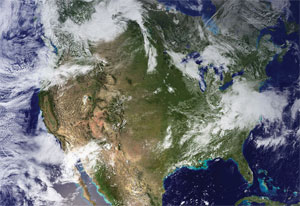We have heard a lot in the past few weeks about the latest international assessment of climate change impacts as new reports have been finalized by the Intergovernmental Panel on Climate Change. Of course climate change is a global phenomenon occurring over decades and, for many, it is hard to relate to new information about global changes. But help is on the way! The third U.S. National Climate Assessment is scheduled for release on May 6.
What is the National Climate Assessment?
This assessment includes detailed discussion of the scientific evidence concerning the consequences of climate change on each region of the U.S.; key sectors of the economy such as transportation, energy, and agriculture; and other important focus areas such as coastal regions, the oceans, urban areas, and natural ecosystems.

The National Climate Assessment highlights the major climate change impacts we are now observing in the U.S. and the impacts that we can reasonably expect to occur in the near future. Photo: NASA
I have been a member of the team of scientists developing this national assessment over the last two years and it has been quite a process. The U.S. Global Change Research Act of 1990 calls for an analysis of the current effects of global change every four years. For this assessment, a committee was formed under the rules of the Federal Advisory Committee Act and members of the committee were appointed according to their expertise, including me.
While these details may seem tedious, they are important because this is not a report scientists are doing on their own, but one that is called for by act of Congress, so that the public and policy makers can hear directly from the scientific community about the evidence regarding global warming, and an interpretation of what that evidence means. And when I say the scientific community, I mean hundreds of scientists across many different disciplines, coming from academia, research institutes, industry, and non-governmental organizations like UCS.
The Federal Advisory Committee Act requires that committees that advise the government be specifically chartered by the government. Committee nominations are available for public comment, conflicts of interest are openly considered, meetings and decisions are open to the public, and there is an opportunity for public comment on the issues before the committee.
Drawing upon evidence from all fields of science
There is substantial academic, peer-reviewed literature on these effects of climate change, but creating a national assessment is not simply a summary of the literature that might be contained in an academic review. The task before us was to synthesize the huge amount of scientific evidence from all fields of science, from physics and chemistry to economics and sociology, to highlight the major impacts we are now observing in the U.S. and the impacts that we can reasonably expect to occur in the near future given what we know about ongoing climate change.
To do that, and to meet needs of both policy makers and the public, the national assessment included a complex and lengthy peer review process. Review by scientists not involved in the assessment for each chapter, review by the National Academy of Sciences, review by Federal agency scientists as well as review by members of the committee for chapters they did not author themselves. And for each part of the review, comments were collated and each comment was addressed by the author team. Trust me, don’t try this at home. But without a doubt it made for a better product.
An example from the oceans
In addition to serving on the executive secretariat for the committee, I was one of the lead authors of the chapter on the oceans. Oddly enough, this is the first time there was a chapter devoted to oceans in the U.S. national assessment. But the role of the oceans in global warming and the evidence of impacts that are already occurring are both very strong.
Much of the increase in global temperatures ends up being stored in the ocean. That has implications for biological productivity and the future trajectory of global warming. For example, one of the reasons that increases in air temperature are hitting a “speed bump” is because more heat has gone into the ocean. But well-documented increases in ocean temperature have profound implications for both the ocean itself and the atmosphere, because the two are intimately connected.
For example, increased atmospheric CO2 results in more CO2 absorbed into the ocean, which leads to overall increased acidity of ocean waters. Ocean acidification is already affecting marine life from corals and plankton to shellfish in certain areas. Like virtually all of the impacts of climate change, the patterns are not uniform from place to place because of complex interactions with other features, including ocean circulation, geology, and so forth. Even so, it is clear that the very nature of the oceans and therefore life in the oceans is changing.
Ongoing assessment of the latest scientific evidence
Finally, the assessment also includes a process for ongoing assessment in future, rather than producing a large document every four years. That is testament to the fact that scientific evidence of climate change and its impacts is coming in at a rapid rate now, and a four-year time window is too long to wait between assessments.
The public, as well as policy makers, the media, educators, private businesses large and small, and yes, scientists everywhere, deserve access to up-to-date information about what we know, how well we know it, and what we think it means.
Climate change is touching virtually every aspect of society, even if everyone doesn’t perceive it in the same way. And we rely on science to help us understand the world around us. Stay tuned.
